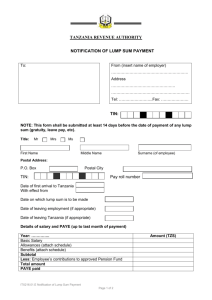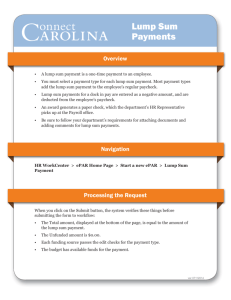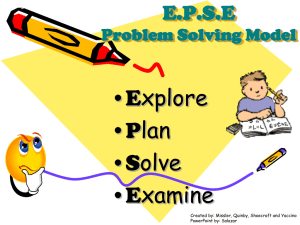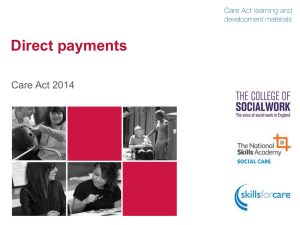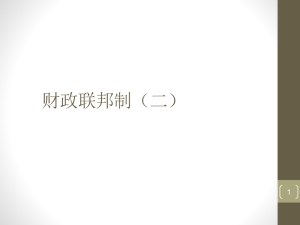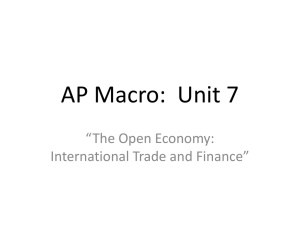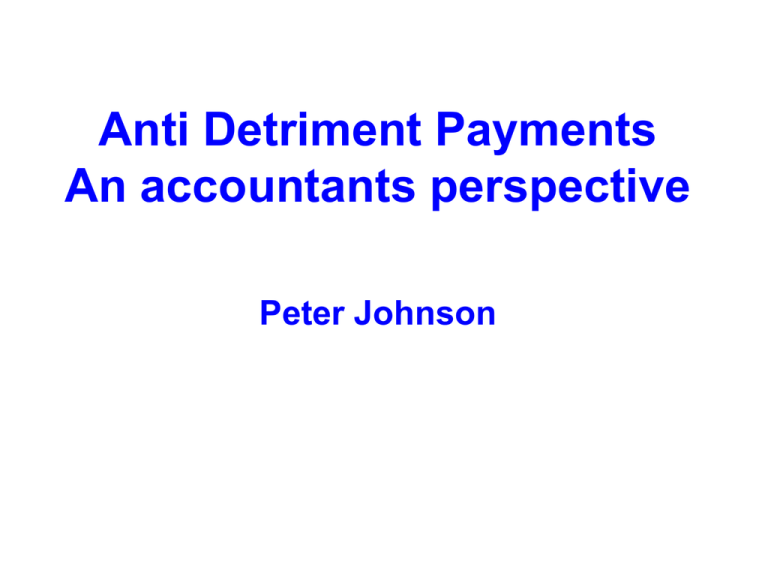
Anti Detriment Payments
An accountants perspective
Peter Johnson
Introduction & Overview
• Prior to 1 July 1988 lump sum payments on death to a dependant
not subject to any tax
• 1 July 1988 Introduction of 15% contributions tax
– Seen as quasi death duties
• Government introduced tax concession on death benefit payments
– Lump sum payment
– Equivalent of Contributions Tax paid by the member
– Restore pre-contributions tax benefit
Anti-Detriment Payments – Peter Johnson
Section 295-485 ITAA 1997
• Prior to 01/07/20007 anti detriment provisions were contained in
Section 279D ITAA 1936
• New Section 295-485 ITAA 1997
• Formula Method Updated in ATO ID 2007/219 and again in 2010/5
• Fund must have been continuously complying since 1 July 1988
• ATO Satisfied full benefit passed on to death benefit recipient
Anti-Detriment Payments – Peter Johnson
•
•
INCOME TAX ASSESSMENT ACT 1997 - SECT 295.485
Deductions for increased amount of superannuation lump sum death
benefit
•
(1)
An entity that is a * complying superannuation fund, or a * complying approved deposit
fund, and has been since 1 July 1988 (or since it came into existence if that was later) can deduct
an amount under this section if:
– (a)
it pays a * superannuation lump sum because of the death of a person to the
trustee of the deceased's estate or an individual who was a * spouse, former spouse or *
child of the deceased at the time of death or payment; and
– (b)
it increases the lump sum by an amount, or does not reduce the lump sum by
an amount (the tax saving amount ) so that the amount of the lump sum is the amount that
the fund could have paid if no tax were payable on amounts included in assessable income
under Subdivision 295-C.
(2)
The fund can deduct the amount in the income year in which the lump sum is paid.
(3)
The amount the fund can deduct is: Tax Savings Amount / Low tax component rate
– where: "low tax component rate" is the rate of tax imposed on the low tax component of the
fund's taxable income for the income year.
(4)
The amount the fund can deduct for a superannuation lump sum paid because of the
death of a person to the trustee of the deceased's estate is so much of the subsection (3) amount
as is appropriate having regard to the extent to which individuals referred to in paragraph (1)(a)
can reasonably be expected to benefit from the estate
•
•
•
Anti-Detriment Payments – Peter Johnson
Who can Receive
• Spouse or Former Spouse of the deceased
– New definition of spouse
– Same Sex Couples
– Interdependency relationship
• Child (if any); or
– Includes step child or adopted child
• The Estate (if ultimate beneficiary is as above)
• Must be paid as a lump sum and benefit paid as a lump sum.
– Within 6 months of death or 3 months of probate (whichever is later)
• Not available on Terminal Illness payment before death
Anti-Detriment Payments – Peter Johnson
Method of Calculation
• Calculate the amount of contributions tax paid by the member on the
death benefit
– Needs to be certified by the auditor
• Formula method acceptable to the commissioner
– ATO ID 2010/5
• Acceptable Formula: (0.15 x P)/(R-0.15 x P) X C where:
– P = number of days in component R that occur after 30/06/1988
– R = Total number of days in the service period after 30/06/1983
– C = Taxable component of lump sum excluding insurance benefits for which tax
deductions have been claimed
– Assumes no untaxed element
• Or use calculator at www.panthercorp.com.au
Anti-Detriment Payments – Peter Johnson
Sources of Anti-Detriment
Payments
• Use a reserve
– Problems if you decide not to pay an anti detriment payment
– S 292.25.01(4) ITAR97
• Life Insurance Policy
– Owned by the fund and not allocated to the member
– Payments are a general expense of the fund and not allocated to the member
– May have a sole purpose test issue
• Take from other members balances:
– Must ensure that the Future Income Tax benefit will be used up
• ATO March 2010 Superannuation Technical Minutes:
– “The true source of the anti-detriment payment is always future income tax
benefit created by the anti-detriment payment. The use of ‘reserve’ is simply one
of the mechanisms used”
Anti-Detriment Payments – Peter Johnson
Other Issues
• Tax Free Pension Income offsets carried forward tax losses
– Consider if you will be paying a pension after claiming the deduction
– Roll out pensioner member to their own fund and leave accumulation members
in the fund
• Re-Contribution Strategies reduce Anti-Detriment amount
– You need to model these numbers
• Maybe roll out members balance to public offer fund if you can plan
that.
– Must ensure that the Fund pays Anti-Detriment Payments
Anti-Detriment Payments – Peter Johnson
Example
• Mum and Dad fund with two kids in the fund
– Both Mum and Dad over 60
– Kids in their 30’s and making contributions
– Assume only asset of the fund is cash
• Balances:
–
–
–
–
Dad: $400,000 – ESP starting 1 July 1980
Mum: $150,000
Child 1: $30,000
Child 2: $20,000
• Dad Dies
– Using Calculator Anti Detriment amount is: $56,166
– Allowable deduction is $374,443
– Death benefit is $456,166
• Source of Funds – other members accounts
Anti-Detriment Payments – Peter Johnson
Example
• Cash payment to mum as beneficiary of $456,166
• Cash Balances after payment:
– Mum: $107,876
– Child 1: $21,575
– Child 2: $14,383
• Plus future income tax benefit of $56,166:
• Accounting Balances after payment:
– Mum: $107,876 cash plus FITB $42,124 = $150,000
– Child 1: $21,575 cash plus FITB $8,425 = $30,000
– Child 2: $14,383 cash plus $5,617 = $20,000
• Need to roll Mum out or pay her a lump sum
Anti-Detriment Payments – Peter Johnson

